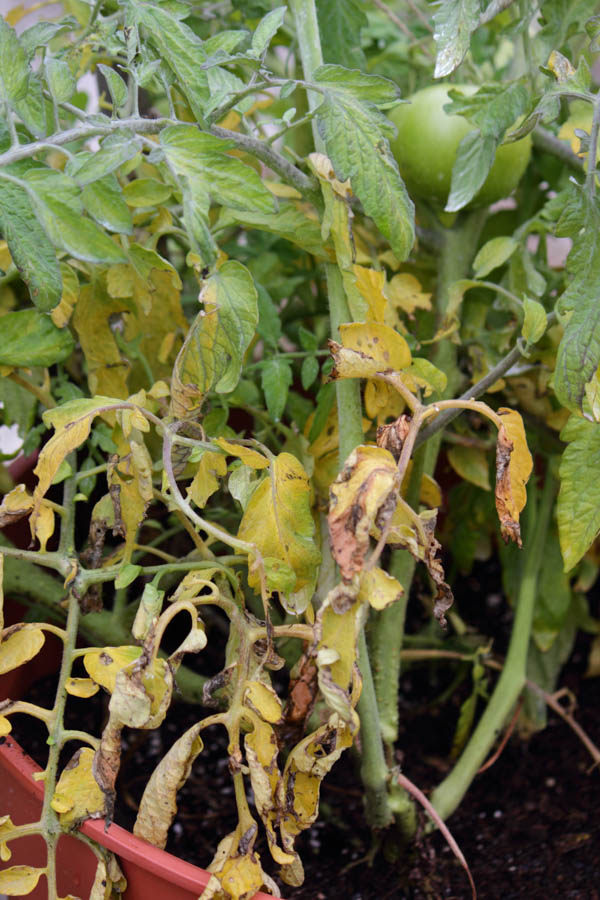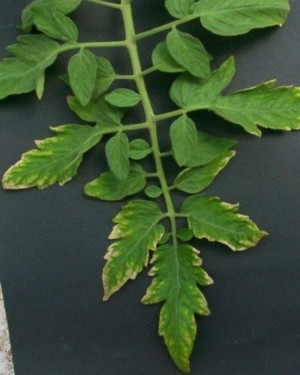25+ Iron Deficiency Tomato Plants
Web Iron Fe deficiency is one of the nutritional issues of plants especially in calcareous soils in which iron-fertilizers are used to solve this obstacle. So it is important to correct iron chlorosis in plants.
How To Grow A Tomato Plant At Home With No Knowledge Of Garden Cores Quora
Web The solution for iron deficiency in plants is to make more soluble iron available to the plants which is best done by treating the soil.

. An ideal soil pH for vegetables is 65 but plants will produce if the pH is in the 60 - 70 range. If the soil pH is too high you can lower it by adding sulfur or peat moss to the soil. Phosphorus is abundant in our soils but may be unavailable to the plant when the soil is too cold.
If the soil is lacking in iron you can add a fertilizer that contains iron sulfate or iron chelate. Web Common Tomato Problems. The total organic acid pool increased significantly with Fe deficiency in xylem sap and leaves of tomato plants whereas it did not change in roots.
Dont plant tomatoes too early in the season. Phosphorus deficiencies Figure 1 occur early in the growing season when soil is still cool. At severe deficiency the leaves may become nearly white and the veins are chlorotic too.
Give iron-deficient plants a boost by spraying foliage with a diluted ferrous sulfate solution. Web Here are the 4 causes of iron chlorosis in tomato plants and what you can do to control this problem. Web Molybdenum Zinc Boron Calcium Copper Iron IPM for Tomato Nitrogen Under N deficiency older leaves gradually change from green to paler green.
Web In the present study we provide compelling evidence that assessment of plant EP in commercial tomato crop contains information to predict Fe deprivation in fertigation. In particular by altering the pH to make soil more acidic so that more nutrients are available in. Incorporate organic matter into the soil prior to.
The effects of Fe deficiency on different metabolic processes were characterized in roots xylem sap and leaves of tomato. Web VDOMDHTMLtml Iron deficiency in tomato plants Is it really Iron or Manganese - YouTube Iron deficiency in tomato plants Plant nutrient deficiencyIron deficiency is a common. Web Improper formation Chlorosis in the new leaves Leaves turn a sickly yellow Plant Iron Deficiency Symptoms An iron deficiency affects the inner upper and new leaves of the plant.
Lets look at what does iron do for plants and how to fix systemic chlorosis in plants. An iron deficiency in plants causes unsightly yellow leaves and eventually death. Excessive Clay Content in the Soil.
From a healthy green to a pale yellow and eventually brown a sort of mottled appearance called intervein chlorosis. A lack of calcium shows up as young leaves curling inwards and lacking colour and is often a problem in acid soils. Leaves approach a yellowish white color under extreme deficiency.
Web The most common cause of iron deficiency in tomato plants is an overfeeding of the plant which can be addressed quickly to improve the health of your crops. Iron chlorosis can be managed in crops in a variety of ways. Web 25K views 2 years ago Agriculture Iron is essential for the formation of chlorophyll which give leaves their green appearance so in iron deficient plants chlorosis yellowing in the new.
Web Iron chlorosis affects many kinds of plants and can be frustrating for a gardener. Use plastic mulch to warm the soil. True iron deficiency is relatively rare but it can develop if your soil is too wet heavily compacted or rich in clay.
This is why it is critical to learn about the causes of nutrient deficiencies and what can be done to prevent or treat them. Apply a premium fertilizer that contains micronutrients. Electrical signal patterns can be modeled to detect iron deficiency prior to visual symptoms appearing in tomato plants.
Intervenial chlorosis occurs resulting in pale leaf veins. Tomato plants thrive in sandy and loamy soil. Web Iron deficiency is a relatively common problem among bedding plants and other spring greenhouse crops.
Web To fix iron deficiency in tomato plants start by testing the soil to determine the nutrient levels and pH. Web Amending the pH too much can cause tomato plants to grow slowly or die off completely. A lack of magnesium shows up as discoloring of the leaves between the veins.
Iron chlorosis is caused by an inadequate amount of iron in the soil or water or by an inadequate amount of iron absorption by plants. They prefer well-draining soil to prevent too much moisture. If the leaves are severely damaged recovery is often impossible.
Web Iron deficiency can occur as a result of a lack of iron in the soil or water or as a result of a lack of iron absorption by the plant. Web Magnesium Mg. If your soil has a large amount of clay iron deficiency may occur in your crops.
Web RossHelen Steps to Treat Iron Deficiency The very first step in diagnosing and treating iron chlorosis is to do a soil test. Web The ideal pH level for tomatoes is between 62 and 68 but plants may grow in more acidic soils with a pH as low as 55. Iron deficiency is most common in sandier soils and soils with a high pH.
Web Results suggest that tomato plants exposed to iron-deficiency are able to change sulfur metabolic balance mimicking sulfur starvation responses to meet the increased demand for methionine and its derivatives allowing them to cope with this stress. Conduct a soil sample test amend the soil with mulch and improve drainage. Iron deficiency symptoms appear as interveinal chlorosis of the youngest foliage when new leaves.
Web Tomato - Chlorosis. Your agricultural extension center can help with soil testing and they may also be able to test a. As the deficiency progresses these older leaves become uniformly yellow chlorotic.
Clay does not. How to Fix It. The main symptom of iron Fe deficiency is chlorosis which usually starts at the shoot tips but more often occurs throughout the entire plant.
Web Typically it is caused by an iron deficiency usually due to a high soil pH pH above 70. Due to the pivotal role of iron the introduction of efficient cost-effective and eco-friendly strategies is necessary to prevent its deficiency in plants. Web Nutrient Deficiencies in Tomatoes Like most plants tomatoes can be affected by deficiencies in macronutrients nitrogen phosphorus potassium calcium magnesium and sulfur and micronutrients primarily iron but also manganese copper zinc boron chlorine molybdenum and nickel.
Plants deficient in Fe show chlorosis of intercostal areas of young leaves followed by yellowing of whole shoot tips.

What Can Be A Reason Of Such Symptoms On Rose Plants In Greenhouse Researchgate

Iron Deficiency In Tomatoes Youtube

4 Iron Deficiency In An Okra Plant Download Scientific Diagram
How To Grow A Tomato Plant At Home With No Knowledge Of Garden Cores Quora

Iron Fe Deficiency Left And A Normal Fe Status In Tomato Plants Download Scientific Diagram
What Do You Call The Little Sprigs That Grow Between The Main Stem And The Branch On A Tomato Plant Quora

Iron Fertilizer Mode Of Action Toxicity Of Iron Sulphate

Yellow Leaves On Tomato Plants A Gardenzeus Guide Part 2 Of 3

Effects Of Spd On Plant Morphology A Dry Weight B Chlorophyll Download Scientific Diagram

Cucumber Plants Grown Under Single Or Combined Molybdenum Mo And Iron Download Scientific Diagram

Using Nanotechnology To Supplement Mg And Fe Deficiencies In Tomato Download Scientific Diagram

Vitamin And Mineral Content Of Tomato 100 G Edible Portion 25 Download Table
Is It Difficult To Grow Your Own Tomatoes Quora

Nutritional Deficiencies In Tomato Crop How To Fix Solutions And Treatment

Tomato Problems Fixing Nutrients Deficiencies Youtube

Tomato Nutrient Deficiencies Haifa Group
Iron Deficiency Tomato Yara Uk